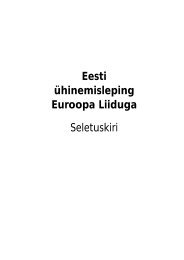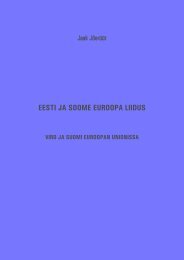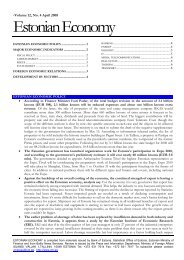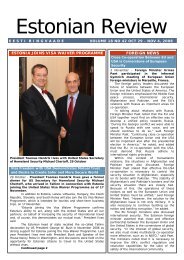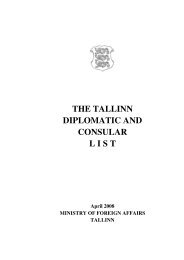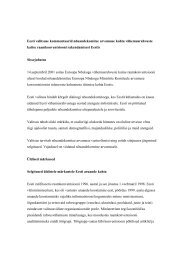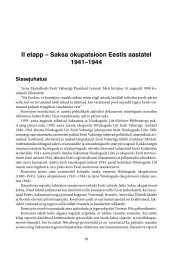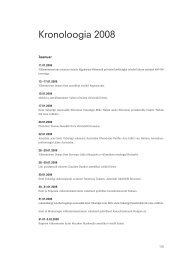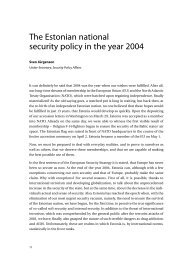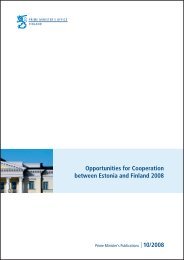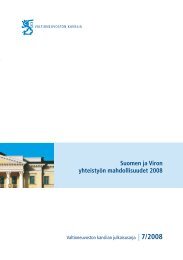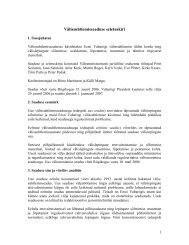The establishment and restoration of Estonian independence and ...
The establishment and restoration of Estonian independence and ...
The establishment and restoration of Estonian independence and ...
Create successful ePaper yourself
Turn your PDF publications into a flip-book with our unique Google optimized e-Paper software.
<strong>The</strong> <strong>establishment</strong> <strong>and</strong><br />
<strong>restoration</strong> <strong>of</strong> <strong>Estonian</strong><br />
<strong>independence</strong> <strong>and</strong> the<br />
development <strong>of</strong> <strong>Estonian</strong><br />
foreign relations<br />
Mart Nutt<br />
Member <strong>of</strong> the <strong>Estonian</strong> Parliament<br />
Until the First World War, <strong>Estonian</strong>s did not even<br />
dare to dream <strong>of</strong> an independent country <strong>of</strong> their<br />
own. However, the war <strong>and</strong> the accompanying<br />
developments demonstrated that <strong>Estonian</strong>s were<br />
mature enough to create their own state <strong>and</strong> had<br />
no wish to fight for the interests <strong>of</strong> other countries.<br />
Many other European nations were also fighting<br />
for freedom <strong>and</strong> <strong>independence</strong> at the same time,<br />
<strong>and</strong> were mutually inspiring each other. By February<br />
24, 1918, a unique power vacuum had developed in Estonia – the retreating<br />
Russian forces had ab<strong>and</strong>oned the capital, Tallinn, while the advancing Germans had<br />
not yet arrived in Tallinn. This gave, for the first time throughout history, <strong>Estonian</strong>s<br />
an opportunity to proclaim their own state – the Republic <strong>of</strong> Estonia. <strong>The</strong> War <strong>of</strong> Independence<br />
that started at the end <strong>of</strong> the year against Russia’s Red Army, <strong>and</strong> later<br />
also against the German supported L<strong>and</strong>eswehr,<br />
ended with Estonia’s victory. On February 2, 1920, By February 24, 1918, a unique<br />
Russia was the first country to recognise the <strong>independence</strong><br />
<strong>of</strong> Estonia. Subsequently, Finl<strong>and</strong> did in Estonia – the retreating<br />
power vacuum had developed<br />
also, followed, a year later, by the Entente, as well Russian forces had ab<strong>and</strong>oned<br />
as the United States in 1922. In 1921, Estonia became<br />
a member <strong>of</strong> the League <strong>of</strong> Nations. Estonia attacking Germans had not<br />
the capital, Tallinn, while the<br />
had become a full <strong>and</strong> equal European state.<br />
yet arrived.<br />
21
2007<br />
ESTONIAN MINISTRY OF FOREIGN AFFAIRS YEARBOOK<br />
September 7, 1917<br />
<strong>The</strong> <strong>Estonian</strong> Provisional L<strong>and</strong><br />
Council resolves to send a delegation<br />
abroad that would introduce<br />
Estonia <strong>and</strong> protect Estonia’s interests.<br />
December 2, 1917<br />
<strong>The</strong> Committee <strong>of</strong> Elders <strong>of</strong> the<br />
<strong>Estonian</strong> Provisional L<strong>and</strong> Council<br />
accredits Ants Piip <strong>and</strong> Jaan Tõnisson<br />
as foreign representatives.<br />
January 1918<br />
Members <strong>of</strong> Estonia`s foreign<br />
delegation, Jaan Poska, Julius<br />
Seljamaa, Jüri Vilms, Ants Piip, <strong>and</strong><br />
Eduard Virgo contact the British,<br />
French, <strong>and</strong> American Embassies in<br />
Petrograd. Poska declares that the<br />
only possible route for Estonia is<br />
to declare <strong>independence</strong>, whereas<br />
the great powers should guarantee<br />
Estonia’s <strong>independence</strong>.<br />
January 25, 1918<br />
Jaan Tõnisson, the head <strong>of</strong> Estonia’s<br />
foreign delegation, arrives in<br />
Stockholm, where he starts to familiarise<br />
the diplomats <strong>of</strong> Sweden<br />
<strong>and</strong> other countries with Estonia’s<br />
aspirations for <strong>independence</strong>.<br />
February 24, 1918<br />
Estonia declares Independence.<br />
May 3, 1918<br />
British Foreign Minister Arthur<br />
Balfour notifies Estonia’s foreign<br />
delegation <strong>of</strong> the readiness <strong>of</strong><br />
His Majesty’s Government to<br />
recog nise the <strong>Estonian</strong> Provisional<br />
L<strong>and</strong> Council as a de facto independent<br />
body, until the beginning<br />
<strong>of</strong> the Peace Conference.<br />
<strong>The</strong> letter also affirms British<br />
readiness to receive Pr<strong>of</strong>essor<br />
Ants Piip as the diplomatic<br />
representative <strong>of</strong> the <strong>Estonian</strong><br />
Provisional Government.<br />
May 13, 1918<br />
French Foreign Minister Stephen<br />
Pichon notifies the members <strong>of</strong><br />
the <strong>Estonian</strong> foreign delegation<br />
that the French Government is<br />
ready to recognise the “<strong>Estonian</strong><br />
National Council”.<br />
August 26, 1919<br />
Estonia becomes a member <strong>of</strong> the<br />
Universal Postal Union.<br />
February 2, 1920<br />
<strong>The</strong> Peace Treaty <strong>of</strong> Tartu is concluded<br />
between the Republic <strong>of</strong><br />
Estonia <strong>and</strong> the Russian Soviet<br />
Federative Socialist Republic,<br />
whereby Russia becomes the<br />
first country to grant de jure<br />
recognition to the Republic <strong>of</strong><br />
Estonia.<br />
February 18, 1920<br />
Italian diplomat Agostino Depretis<br />
is the first diplomatic representative<br />
<strong>of</strong> a great Western power to<br />
present his credentials.<br />
June 7, 1920<br />
Finl<strong>and</strong> grants de jure recognition<br />
to the Republic <strong>of</strong> Estonia.<br />
December 31, 1920<br />
Pol<strong>and</strong> grants de jure recognition<br />
to Estonia’s <strong>independence</strong>.<br />
January 26, 1921<br />
<strong>The</strong> Entente’s Supreme Council<br />
grants de jure recognition to Estonia’s<br />
<strong>independence</strong>.<br />
February 5, 1921<br />
Sweden, Denmark, <strong>and</strong> Norway<br />
recognise <strong>Estonian</strong> <strong>independence</strong>.<br />
February 22, 1921<br />
<strong>The</strong> Assembly <strong>of</strong> the League <strong>of</strong><br />
Nations votes in favour <strong>of</strong> Estonia<br />
becoming a member <strong>of</strong> the League<br />
<strong>of</strong> Nations.<br />
July 28, 1922<br />
<strong>The</strong> United States <strong>of</strong> America<br />
grants de jure recognition to the<br />
Republic <strong>of</strong> Estonia.<br />
September 21, 1944<br />
Through Estonia’s representatives<br />
abroad, the government <strong>of</strong> the Republic<br />
<strong>of</strong> Estonia, formed in Tallinn,<br />
notifies the outside world <strong>of</strong> the<br />
continuation <strong>of</strong> the activities <strong>of</strong> Estonia’s<br />
legal government in exile.<br />
1989<br />
At Lennart Meri’s initiative, the<br />
<strong>Estonian</strong> Institute is founded in order<br />
to introduce Estonia in friendly<br />
Western countries.<br />
April 11, 1990<br />
Lennart Meri becomes the foreign<br />
minister <strong>of</strong> Estonia.<br />
22
THE ESTABLISHMENT AND RESTORATION OF ESTONIAN INDEPENDENCE AND<br />
THE DEVELOPMENT OF ESTONIAN FOREIGN RELATIONS<br />
2007<br />
January 13, 1991<br />
After the bloodshed that takes<br />
place in Lithuania with the approval<br />
<strong>of</strong> the Soviet leadership,<br />
Estonia, Latvia, Lithuania, <strong>and</strong> the<br />
Russian SFSR adopt a joint declaration<br />
that is sent to the UN secretary-general.<br />
August 22, 1991<br />
Icel<strong>and</strong> recognises <strong>restoration</strong> <strong>of</strong><br />
the <strong>independence</strong> <strong>of</strong> Estonia.<br />
on Security <strong>and</strong> Cooperation in<br />
Europe).<br />
September 17, 1991<br />
<strong>The</strong> Republic <strong>of</strong> Estonia joins the<br />
United Nations.<br />
July 1992<br />
Great Britain restores visa-free<br />
travel for <strong>Estonian</strong> citizens, being<br />
the first European Union state to<br />
restore a pre-war agreement.<br />
May 1, 2004<br />
Estonia becomes a European Union<br />
member state.<br />
December 2007<br />
Estonia is invited to start accession<br />
negotiations with the OECD<br />
(Organisation for Economic Cooperation<br />
<strong>and</strong> Development)<br />
December 21, 2007<br />
Estonia joins the Schengen area.<br />
August 24, 1991<br />
Russia re-recognises Estonia.<br />
August 25, 1991<br />
France re-recognises Estonia.<br />
August 27, 1991<br />
Great Britain reaffirms its recognition<br />
<strong>of</strong> the Republic <strong>of</strong> Estonia.<br />
August 27, 1991<br />
Sweden re-recognises Estonia.<br />
August 28, 1991<br />
Diplomatic relations between Estonia<br />
<strong>and</strong> Germany are restored.<br />
August 29, 1991<br />
Sweden becomes the first country<br />
to open its embassy in Tallinn.<br />
September 4, 1992<br />
<strong>The</strong> Unites States restores its mission<br />
(embassy) in Tallinn.<br />
May 14, 1993<br />
Estonia becomes a member <strong>of</strong> the<br />
Council <strong>of</strong> Europe.<br />
July 26, 1994<br />
In Moscow, <strong>Estonian</strong> President<br />
Lennart Meri <strong>and</strong> Russian President<br />
Boris Yeltsin sign an agreement<br />
for the complete withdrawal<br />
<strong>of</strong> Russian troops from<br />
Estonia.<br />
February 16, 1998<br />
<strong>The</strong> Charter <strong>of</strong> Partnership between<br />
Estonia, Latvia, Lithuania, <strong>and</strong> the<br />
United States is signed.<br />
September 6, 1991<br />
<strong>The</strong> Soviet Union recognises Estonia’s<br />
<strong>independence</strong>.<br />
March 31, 1998<br />
<strong>The</strong> European Union starts accession<br />
negotiations with Estonia.<br />
September 10, 1991<br />
Estonia is accepted as a member<br />
<strong>of</strong> the CSCE (Conference<br />
April 29, 2004<br />
Estonia becomes a member <strong>of</strong><br />
NATO.<br />
23
2007<br />
ESTONIAN MINISTRY OF FOREIGN AFFAIRS YEARBOOK<br />
<strong>The</strong> birth <strong>of</strong> the Republic <strong>of</strong> Estonia was not only<br />
the result <strong>of</strong> a victorious war, but also the fruit <strong>of</strong><br />
successful diplomacy. Already during the World<br />
War, in September 1917, while Estonia was still<br />
part <strong>of</strong> Russia, the <strong>Estonian</strong> Provisional L<strong>and</strong><br />
Council (Maapäev) decided to send a delegation<br />
abroad to represent <strong>Estonian</strong> interests.<br />
<strong>The</strong> birth <strong>of</strong> the Republic <strong>of</strong><br />
Estonia was not only the result<br />
<strong>of</strong> a victorious war, but<br />
also the fruit <strong>of</strong> successful diplomacy.<br />
This foreign delegation was formed already by December 2, 1917. Ants Piip <strong>and</strong> Jaan<br />
Tõnisson were <strong>of</strong>ficially appointed to be foreign representatives, <strong>and</strong> the establishing<br />
<strong>of</strong> Estonia’s foreign missions was launched. By the time the Tartu Peace Treaty was<br />
concluded in February 1920, Estonia already had a functioning foreign service consisting<br />
<strong>of</strong> young diplomats who were quickly acquiring experience <strong>and</strong> know-how.<br />
On February 24, 1918, Estonia’s first foreign minister, Jaan Poska, assumed <strong>of</strong>fice.<br />
Contacts with the governments <strong>of</strong> other countries resulted in the de facto recognition,<br />
by Great Britain <strong>and</strong> France, in May 1918, <strong>of</strong> the credentials <strong>of</strong> the <strong>Estonian</strong> Provisional<br />
L<strong>and</strong> Council. Although an <strong>Estonian</strong> delegation was not invited to the Paris<br />
Peace Conference, Estonia’s representatives were treated as governmental representatives.<br />
On August 26, 1919, Estonia became a member <strong>of</strong> the Universal Postal Union,<br />
which marked the beginning <strong>of</strong> Estonia’s status as a subject under international law.<br />
<strong>The</strong>reby, Estonia had an independent foreign policy, as well as conducted foreign relations,<br />
already from the spring <strong>of</strong> 1918 on, which gradually dispersed the scepticism<br />
concerning the survival <strong>of</strong> the <strong>Estonian</strong> state.<br />
<strong>The</strong> Foreign Minister <strong>of</strong> Estonia Jaan Poska signs the Tartu Peace Treaty. Tartu, 2 February 1920<br />
24
THE ESTABLISHMENT AND RESTORATION OF ESTONIAN INDEPENDENCE AND<br />
THE DEVELOPMENT OF ESTONIAN FOREIGN RELATIONS<br />
2007<br />
In the 1920’s <strong>and</strong> 1930’s, Estonia had diplomatic relations with many European countries,<br />
<strong>and</strong> the existence <strong>of</strong> a Turkish Embassy in Tallinn demonstrated that Estonia was also <strong>of</strong><br />
interest to more distant countries. Normal development continued until 1939, when the<br />
expansionism <strong>of</strong> the great totalitarian powers hurled the nations <strong>of</strong> the world into the<br />
Second World War.<br />
International status <strong>and</strong> foreign relations during the occupations<br />
In August 1939, with the secret protocols <strong>of</strong> the Molotov-Ribbentrop Pact, the Soviet<br />
Union <strong>and</strong> Germany divided Central Europe into spheres <strong>of</strong> influence. And, only a few<br />
days later, both countries attacked Pol<strong>and</strong>. By the late spring <strong>of</strong> 1940, the majority <strong>of</strong><br />
European countries had been dragged into the war.<br />
On June 17, 1940, the Soviet Union occupied Estonia.<br />
On July 23, 1940, the U.S.<br />
On August 6, the <strong>Estonian</strong> state was formally State Department publicly<br />
dissolved <strong>and</strong> annexed by the Soviet Union. But the<br />
Soviet Union was not able to obtain recognition for<br />
condemned the annexation <strong>of</strong><br />
the Baltic countries.<br />
this occupation <strong>and</strong> annexation. <strong>The</strong> United States<br />
reacted sharply to the occupation <strong>of</strong> the Baltic states. On July 23, 1940, the U.S. State Department<br />
publicly condemned the annexation <strong>of</strong> the Baltic states. <strong>The</strong> United States based<br />
its non-recognition policy on the doctrine <strong>of</strong> Secretary <strong>of</strong> State Stimson, which was proclaimed<br />
in September 1932 in connection with the Japanese aggression against China.<br />
This meant that the United States refused to recognise any territorial changes, agreements<br />
or treaties that had been achieved by force. <strong>The</strong> U.S. government continued to<br />
recognise the Baltic representations on its territory. Similarly to the United States, many<br />
other Western countries also followed a policy <strong>of</strong> non-recognition, <strong>and</strong> in several <strong>of</strong><br />
them, <strong>Estonian</strong> missions were able to carry on their activities. <strong>The</strong> <strong>Estonian</strong> Consulate<br />
General in New York has been functioning, consistently, to this day, even despite <strong>and</strong><br />
throughout the foreign occupations that lasted for more than half a century. At the same<br />
time, all foreign countries were forced to close their missions in Estonia. However, when<br />
the United States closed its Embassy in Tallinn on August 13, 1940, it affirmed that it was<br />
doing so only under duress. Similarly to 1918, the <strong>Estonian</strong> Government, in September<br />
1944, attempted to again initiate activities in the power vacuum between two occupying<br />
countries – the German forces were leaving Tallinn, <strong>and</strong> the first Soviet units had not yet<br />
arrived. On September 21, 1944, the Government informed the <strong>Estonian</strong> people <strong>and</strong> the<br />
rest <strong>of</strong> the world <strong>of</strong> Estonia’s neutrality in the Soviet-German conflict, <strong>and</strong> <strong>of</strong> the need<br />
to continue the activities <strong>of</strong> the Government, on behalf <strong>of</strong> the fight for <strong>independence</strong>, in<br />
exile. <strong>The</strong> foreign representatives <strong>of</strong> the Republic <strong>of</strong> Estonia were also informed <strong>of</strong> the<br />
Government’s declaration. <strong>The</strong> <strong>Estonian</strong> ambassador in London <strong>of</strong>ficially forwarded this<br />
declaration to the British Foreign Ministry. <strong>The</strong> fact is that the ensuing Soviet occupation<br />
did force the <strong>Estonian</strong> Govern ment to continue its activities in exile.<br />
25
2007<br />
ESTONIAN MINISTRY OF FOREIGN AFFAIRS YEARBOOK<br />
<strong>The</strong> U.S. non-recognition policy influen ced the <strong>The</strong> U.S. policy <strong>of</strong> non-recognition<br />
affected the attitude <strong>of</strong><br />
whole world’s attitu de towards the Baltic states.<br />
In various contexts, during <strong>and</strong> after the Second the entire world towards the<br />
World War, several countries declared that they Baltic states.<br />
did not recognise the illegal incorporation <strong>of</strong> Estonia<br />
<strong>and</strong> the other Baltic states into the Soviet<br />
Union. <strong>The</strong>refore, according to international law, the Republic <strong>of</strong> Estonia continued to<br />
exist de jure, in spite <strong>of</strong> its de facto occupation <strong>and</strong> annexation by the Soviet Union.<br />
<strong>The</strong> <strong>restoration</strong> <strong>of</strong> <strong>independence</strong><br />
Perestroika, initiated by Mikhail Gorbachev, brought about a liberalization <strong>of</strong> political<br />
life. In Estonia, this was accompanied by the wish to end the injustice caused by the<br />
Molotov-Ribbentrop Pact, <strong>and</strong> to restore the <strong>independence</strong> <strong>of</strong> the nation that had been<br />
occupied <strong>and</strong> annexed in 1940. On November 12, 1989, Supreme Soviet <strong>of</strong> the <strong>Estonian</strong><br />
Soviet Socialist Republic (SSR) passed a resolution, entitled “A Historical-Legal Assessment<br />
<strong>of</strong> the Events That Occurred in Estonia in 1940”, whereby it defined the events<br />
that had taken place in Estonia in 1940 as acts <strong>of</strong> aggression, as a military occupation,<br />
<strong>and</strong> as an illegal annexation <strong>of</strong> the Republic <strong>of</strong> Estonia by the Soviet Union. <strong>The</strong>refore,<br />
it was declared that the forcible change <strong>of</strong> the polity <strong>of</strong> the Republic <strong>of</strong> Estonia was<br />
invalid from the viewpoint <strong>of</strong> international law, which meant that the injecting <strong>of</strong> the<br />
Republic <strong>of</strong> Estonia into the composition <strong>of</strong> the Soviet Union was null <strong>and</strong> void.<br />
<strong>The</strong> idea <strong>of</strong> restitution was based on two principles:<br />
Estonia continued to be a state that had based on two principles: Esto-<br />
<strong>The</strong> idea <strong>of</strong> restitution was<br />
international de jure recognition, with its foreign nia continued to be a country<br />
relations being conducted by foreign representations<br />
<strong>of</strong> the Republic <strong>of</strong> Estonia that had contin-<br />
recognition, with foreign re-<br />
that had international de jure<br />
ued accreditation (the Consulate General <strong>of</strong> the lations that were conducted<br />
Republic <strong>of</strong> Estonia in New York). An <strong>Estonian</strong> by foreign representations <strong>of</strong><br />
citizenry also existed, which had the right to determine<br />
Estonia’s statehood. <strong>The</strong> resolution <strong>of</strong> the continued accreditation (Con-<br />
the Republic <strong>of</strong> Estonia with<br />
<strong>Estonian</strong> SSR Supreme Soviet <strong>of</strong> March 30, 1990, sulate General <strong>of</strong> the Republic<br />
regarding the status <strong>of</strong> Estonia’s statehood, declared<br />
that the occupation <strong>of</strong> Estonia by the Soviet <strong>Estonian</strong> citizenry also existed,<br />
<strong>of</strong> Estonia in New York). An<br />
Union on June 17, 1940, had not terminated the who had the right to determine<br />
existence <strong>of</strong> the Republic <strong>of</strong> Estonia de jure, <strong>and</strong> Estonia’s statehood.<br />
that the territory <strong>of</strong> the Republic <strong>of</strong> Estonia continued<br />
to be occupied up until that time. Based thereon, the <strong>Estonian</strong> SSR Supreme<br />
Soviet declared that the governmental power <strong>of</strong> the Soviet Union in Estonia had been<br />
illegal from the moment <strong>of</strong> its <strong>establishment</strong> on, <strong>and</strong> announced the <strong>restoration</strong> <strong>of</strong> the<br />
Republic <strong>of</strong> Estonia (restitutio ad integrum). <strong>The</strong> resolution also established a transi-<br />
26
THE ESTABLISHMENT AND RESTORATION OF ESTONIAN INDEPENDENCE AND<br />
THE DEVELOPMENT OF ESTONIAN FOREIGN RELATIONS<br />
2007<br />
tion period, which was to last until the formation <strong>of</strong> the Republic <strong>of</strong> Estonia’s organs<br />
<strong>of</strong> constitutional authority.<br />
In May <strong>of</strong> 1990, the use <strong>of</strong> the term “<strong>Estonian</strong> SSR” was ab<strong>and</strong>oned, <strong>and</strong> the term<br />
“Republic <strong>of</strong> Estonia” was reinstituted as the <strong>of</strong>ficial name <strong>of</strong> the state. <strong>The</strong>reby, the<br />
<strong>Estonian</strong> Supreme Soviet declared that Estonia was an independent <strong>and</strong> autonomous<br />
republic, <strong>and</strong> that only the laws instated by it were valid in Estonia. But at that moment<br />
in time, Estonia was not able to put these provisions into practice.<br />
By the beginning <strong>of</strong> April 1990, a memor<strong>and</strong>um had been drawn up, that the <strong>Estonian</strong><br />
SSR Supreme Soviet <strong>and</strong> the Committee <strong>of</strong> Estonia 1 used to approach the governments<br />
<strong>of</strong> all European countries, the United States, <strong>and</strong> Canada with the appeal that<br />
the issue <strong>of</strong> the <strong>restoration</strong> <strong>of</strong> the <strong>independence</strong> <strong>of</strong> the Republic <strong>of</strong> Estonia, that had<br />
been lost during the Second World War, be added to the Conference on Security <strong>and</strong><br />
Cooperation in Europe (CSCE) agenda in 1990 as a subject <strong>of</strong> international law. This<br />
was the first legal document, related to foreign relations, passed by the <strong>Estonian</strong> SSR<br />
Supreme Soviet, which, essentially, directed the Foreign Ministry to re-establish its<br />
activities as the coordinator <strong>of</strong> the state’s foreign policy. Lennart Meri, who had taken<br />
<strong>of</strong>fice as minister, energetically started to do just that.<br />
At Lennart Meri’s initiative, the <strong>Estonian</strong> Institute<br />
had already been created in 1989, in order to introduce<br />
the issue <strong>of</strong> Estonia to foreign countries. As<br />
foreign minister, Meri skillfully used the existing<br />
network <strong>of</strong> <strong>Estonian</strong> cultural representations (not<br />
only the <strong>Estonian</strong> Institute <strong>of</strong>fices abroad, but also<br />
organisations like the Tuglas Society in Finl<strong>and</strong>)<br />
as “proto-embassies”, which shouldered the task<br />
<strong>of</strong> being un<strong>of</strong>ficial representations for Estonia’s<br />
govern mental <strong>and</strong> foreign policy.<br />
As foreign minister, Meri<br />
skillfully used the network <strong>of</strong><br />
<strong>Estonian</strong> cultural representations<br />
(for instance the Tuglas<br />
So ciety in Finl<strong>and</strong>) as “protoembassies”,<br />
which shouldered<br />
the task <strong>of</strong> being un<strong>of</strong>ficial<br />
representations for Estonia’s governmental<br />
<strong>and</strong> foreign policy.<br />
<strong>The</strong> <strong>Estonian</strong> authorities emphasized that contacts with the Soviet Union should be<br />
treated as negotiations, or, in other words, as being a part <strong>of</strong> Estonia’s foreign relations,<br />
which Moscow strongly resisted. In the summer <strong>of</strong> 1990, the Government <strong>of</strong><br />
the Republic <strong>of</strong> Estonia formed appropriate commissions for negotiating with Moscow,<br />
<strong>and</strong> negotiations were started at the end <strong>of</strong> August. <strong>The</strong> Soviet Union called the<br />
negotiations consultations. Moscow finally arrived at the conclusion that the most<br />
suitable solution would be to conclude a union treaty, <strong>and</strong> to force the Baltic states<br />
1<br />
<strong>The</strong> executive organ <strong>of</strong> the <strong>Estonian</strong> Congress, a representative body that had been elected, by the citizens <strong>of</strong><br />
the Republic <strong>of</strong> Estonia, at the people’s own initiative.<br />
27
2007<br />
ESTONIAN MINISTRY OF FOREIGN AFFAIRS YEARBOOK<br />
to sign it, thereby reattaching them to the Soviet Union. An important role in ending<br />
the January crisis <strong>and</strong> avoiding bloodshed in Estonia was played by the support <strong>of</strong><br />
the Russian SFSR for the Baltic states. On January 12, 1991, Estonia <strong>and</strong> the Russian<br />
SFSR signed the Treaty <strong>of</strong> Interstate Relations, whereby both parties recognised each<br />
other’s inalienable right to national <strong>independence</strong>. Both countries mutually recognised<br />
each other as sovereign states <strong>and</strong> as being subject to international law. On January<br />
13, Boris Yeltsin <strong>and</strong> Arnold Rüütel signed a joint declaration in Tallinn, whereby both<br />
parties mutually recognised the other’s national sovereignty <strong>and</strong> legally elected organs<br />
<strong>of</strong> state authority. A joint dispatch was sent to Perez de Cuellar, the secretary-general<br />
<strong>of</strong> the United Nations (UN), requesting that he convene an international conference to<br />
find a solution to the Baltic crisis.<br />
<strong>The</strong> foreign policy activities <strong>of</strong> the Baltic states saw a further increase in the spring<br />
<strong>of</strong> 1991. At the beginning <strong>of</strong> May 1991, the government leaders <strong>of</strong> Estonia <strong>and</strong> Latvia,<br />
as well as the chairman <strong>of</strong> the Lithuanian Supreme Soviet, made a joint declaration,<br />
in Washington, requesting international recognition <strong>and</strong> protection. An appeal was<br />
made to the world’s public that the Baltic states be treated as independent countries<br />
in the international arena. However, the international community was not yet ready<br />
for such recognition.<br />
<strong>The</strong> beginning <strong>of</strong> re-independent Estonia’s foreign relations<br />
On August 20, 1991, in a situation in which the capital <strong>of</strong> the Soviet Union had fallen<br />
under the control <strong>of</strong> the State Emergency Committee, that was in the process <strong>of</strong> trying<br />
to carry out a coup, <strong>and</strong> in which Soviet troops had entered Tallinn <strong>and</strong> were waiting<br />
for the order to remove the administration <strong>of</strong> the Republic <strong>of</strong> Estonia from power,<br />
the <strong>Estonian</strong> Supreme Soviet passed a resolution regarding Estonia’s national <strong>independence</strong>,<br />
which upheld the national <strong>independence</strong> <strong>of</strong> the Republic <strong>of</strong> Estonia, <strong>and</strong><br />
endorsed the quest to restore diplomatic relations. <strong>The</strong> same resolution resolved to<br />
create a Constitutional Assembly, from amongst the delegates <strong>of</strong> the Supreme Soviet<br />
<strong>and</strong> the <strong>Estonian</strong> Congress, to formulate the Constitution <strong>of</strong> the Republic <strong>of</strong> Estonia.<br />
<strong>The</strong> suppression <strong>of</strong> the August putsch provided the opportunity for restoring the <strong>independence</strong><br />
<strong>of</strong> the Baltic states, <strong>and</strong> accelerated the dissolution <strong>of</strong> the Soviet Union,<br />
which was capped <strong>of</strong>f by the Belovezh Accords in December 1991.<br />
<strong>The</strong> <strong>restoration</strong> <strong>of</strong> the Republic <strong>of</strong> Estonia by restitution, <strong>and</strong> not by the creation <strong>of</strong> a<br />
new state that had seceded from the Soviet Union, met with approval by the countries<br />
that had adhered to the non-recognition policy.<br />
Icel<strong>and</strong>, whose parliament had already passed a resolution regarding Lithuania on February<br />
11, 1991, in which it confirmed that the recognition granted to the <strong>independence</strong><br />
28
THE ESTABLISHMENT AND RESTORATION OF ESTONIAN INDEPENDENCE AND<br />
THE DEVELOPMENT OF ESTONIAN FOREIGN RELATIONS<br />
2007<br />
<strong>of</strong> the Republic <strong>of</strong> Lithuania, by Icel<strong>and</strong>, in 1922, was still in force, took the same<br />
position regarding Estonia <strong>and</strong> Latvia when they declared the <strong>restoration</strong> <strong>of</strong> their <strong>independence</strong><br />
in August 1991. Thus, Icel<strong>and</strong> was the first country to recognise the regained<br />
<strong>independence</strong> <strong>of</strong> Estonia. Other Western countries supported <strong>and</strong> recognised the idea<br />
<strong>of</strong> treating the Baltic states on the basis <strong>of</strong> the relations that existed before World War<br />
II when, in August <strong>and</strong> September <strong>of</strong> 1991, they announced that they are restoring<br />
diplomatic relations with Estonia, Latvia, <strong>and</strong> Lithuania. Actually, the countries <strong>of</strong> the<br />
European Community, as well as the United States, did not use the word “recognition”<br />
in their declarations. For instance, on August 27, 1991, a special meeting <strong>of</strong> the foreign<br />
ministers <strong>of</strong> the European Community welcomed the fact that the Baltic states had<br />
restored the sovereignty <strong>and</strong> <strong>independence</strong> that<br />
they had lost in 1940, <strong>and</strong> confirmed the members’ On August 27, 1991, a special<br />
decision to immediately establish diplomatic relations.<br />
<strong>The</strong> U.S. held a similar position. President ters <strong>of</strong> the European Commu-<br />
meeting <strong>of</strong> the foreign minis-<br />
George Bush announced that the <strong>restoration</strong> <strong>of</strong> the nity welcomed the fact that the<br />
<strong>independence</strong> <strong>of</strong> the Baltic states was the “culmination<br />
<strong>of</strong> the 52-year policy <strong>of</strong> the United States not sovereignty <strong>and</strong> <strong>independence</strong><br />
Baltic states had restored the<br />
to recognise the incorporation <strong>of</strong> the independent that they had lost in 1940, <strong>and</strong><br />
Baltic states by the Soviet Union.” <strong>The</strong> countries confirmed the members’ decision<br />
to immediately establish<br />
that had formerly belonged to the “socialist camp”<br />
also recognised the <strong>independence</strong> <strong>of</strong> the Baltic diplomatic relations. <strong>The</strong> U.S.<br />
states on the basis <strong>of</strong> the relations that had existed held a similar position.<br />
before the Second World War.<br />
On September 6, 1991, the Soviet Union also recognised the <strong>independence</strong> <strong>of</strong> Estonia.<br />
On September 10, Estonia became a member <strong>of</strong> the CSCE, <strong>and</strong> on September 17, a<br />
member <strong>of</strong> the UN. At the end <strong>of</strong> that year, Estonia also became a member <strong>of</strong> the<br />
North Atlantic Cooperation Council.<br />
<strong>The</strong> recognition <strong>of</strong> pre-WW II relationship with the Baltic states was later confirmed<br />
by how international agreements were concluded. A general model was applied here –<br />
the contractual obligations <strong>of</strong> the Soviet Union were not considered to be automatically<br />
binding for the Republics <strong>of</strong> Estonia, Latvia, <strong>and</strong> Lithuania. Based on the legal<br />
succession <strong>of</strong> a pre-WW II state, the <strong>Estonian</strong> government <strong>of</strong>ficially notified the UN<br />
secretary-general that it does not consider itself, in the context <strong>of</strong> legal succession, to<br />
be party to any bilateral or multilateral agreement concluded by the Soviet Union.<br />
Restoration as an independent state entailed the rapid development <strong>of</strong> Estonia’s foreign<br />
relations. First <strong>of</strong> all, this required accession to multilateral international agreements<br />
that had been concluded when Estonia could not participate in foreign relations<br />
as a subject under international law, <strong>and</strong> therefore, many generally recognised<br />
29
2007<br />
ESTONIAN MINISTRY OF FOREIGN AFFAIRS YEARBOOK<br />
international statutes did not apply to Estonia. On October 21, 1991, Estonia acceded<br />
to twenty-eight international conventions regarding contract law, the peaceful solving<br />
<strong>of</strong> disputes, human rights, as well as diplomatic <strong>and</strong> consular issues.<br />
At the same time, legal continuity with the pre-war Republic <strong>of</strong> Estonia resulted in<br />
questions regarding the validity <strong>of</strong> agreements signed before June 16, 1940. On June 26,<br />
1992, the <strong>Estonian</strong> foreign minister signed a declaration addressed to the UN secretary-general,<br />
confirming that Estonia considered the Convention on the Non-Fortification<br />
<strong>and</strong> Neutralization <strong>of</strong> the Ål<strong>and</strong> Isl<strong>and</strong>s (signed in 1921) to be binding. This was<br />
followed by the <strong>restoration</strong> <strong>of</strong> Estonia’s membership in the conventions that Estonia<br />
had acceded to before the Second World War that still remained in force. In the case<br />
<strong>of</strong> bilateral pre-war agreements, the validity <strong>of</strong> some, but not all, was recognised.<br />
<strong>The</strong>reafter, Estonia’s long-term foreign <strong>and</strong> national<br />
security policy priority became the matter<br />
<strong>of</strong> joining the North Atlantic Treaty Organisation<br />
<strong>and</strong> acceding to the European Union.<br />
Estonia’s long-term foreign<br />
<strong>and</strong> security priority became<br />
joining NATO <strong>and</strong> acceding to<br />
the European Union.<br />
30



